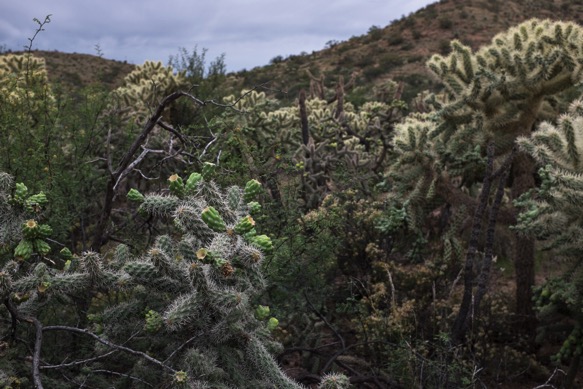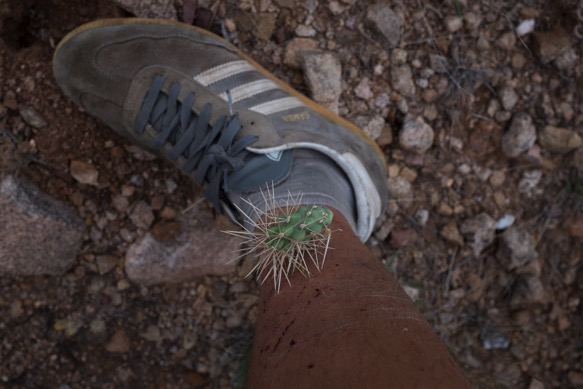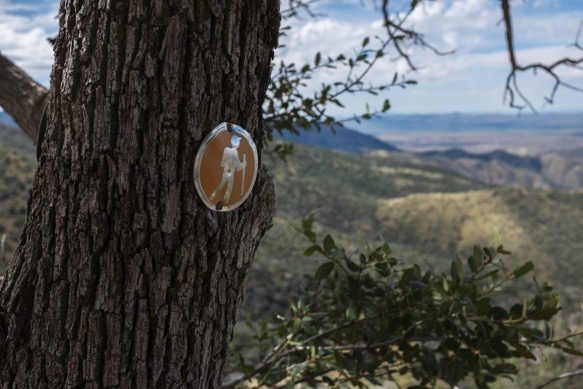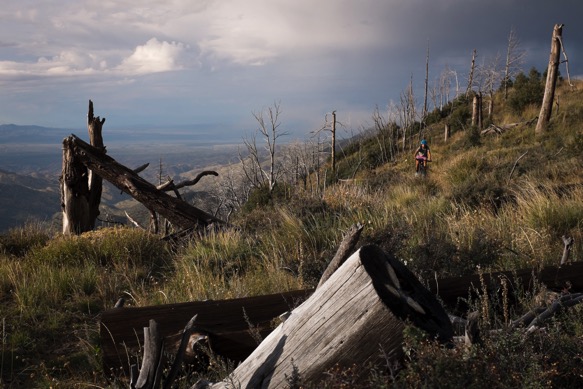
We’re off to Baja for a few months! Lael is riding her new Advocate Cycles Hayduke, a steel 27.5+ hardtail, and I am riding my pink Meriwether. Thanks to the donation of a used iPhone from a friend, as a multi-purpose travel device, we now both have Instagram accounts. Follow us there at @laelwilcox and @nicholascarman.
The first moment in long pants and a sweater, come fall. The first afternoon in short sleeves and a shirt, when rotting piles of snow linger in the shadows and thin blades of grass emerge from the matted brown lawn. It is the leading edge of any season which I especially relish. For more than a month, we’ve ridden the breaking wave of winter across Arizona and New Mexico, through New York and the Mid Atlantic, and now through California and Baja California. But it isn’t meant to be. We’re headed south for the season.
On Wellesley Island, NY, where my parents now live, I encountered an entire harvest of apples beneath a tree, forgotten by nearby residents in favor of store bought varieties. And the next day, an inch and a half of snow covers them. In Baja, we’ve encountered freezing nights just several hundred feet above sea level, yet warm dry nights at elevation, a phenomena which continues to elude me. Above, at nearly 10,000ft, a dusting of snow falls on the Sierra de San Pedro Martir. Yet Washington D.C. is the coldest place I’ve been in the past month, where winter threatens with cloudy skies and 39 degree rain. I say anything is better than 39 degree rain. Give me Alaska, Minnesota, or New York in February, but never cold rain. Any time we ride in 39 degree rain, Lael reminds me of the last time we rode to Baja from Tacoma, WA. We left on November 16th, 2009 to ride south, and it rained every day until we crossed the border. The final week in Southern California at the end of December amounted to record rainfall.
Our time in Arizona concluded with Lael’s AZT750 ITT attempt, a pursuit which has been captured as part of a brief documentary feature, set to be released this spring. More on that when it is released next year, but the process of filming was enlightening and a lot of fun. Expect aerial drone shots of Lael. What could be more fun than aerial drone shots of a girl riding her bike and eating, pissing in the bushes, hurriedly buying a dozen cookies from a small grocery?
For the filming, I was contracted to help scout film locations on the backcountry route and to transport Lael to the start. Thus, a vehicle was rented in my name and for almost two weeks, I piloted a small Chevy Sonic around the state, bashing the undercarriage on all manner of unpaved roads. That’s why you get the full insurance. After the ITT attempt, we spent a weekend in Santa Fe to finish some filming, which gave us the chance to reconnect with some friends in New Mexico, crossing paths with Rusty and Melissa; Cass, Nancy, and Sage; John, Jeremy, and Owen. Each of these people play a role in our lives. Rusty arrived in Albuquerque the week we were leaving and took a job at Two Wheel Drive where I had worked; Melissa is riding my old Raleigh XXIX; we stayed with John’s high school friend in Athens and recently John went to ride the Bike Odyssey route in Greece; Owen sold Lael her first upright touring bars, some secondhand On-One Mary cruisers which we used to replace the drop bars on her LHT; Cass and I have crossed paths more than a few times, dating back to the summer of 2009 in Alaska; and, I believe, I was present to witness Nancy’s first day of her first bike tour, as two inches of snow fell while we climbed up Lynx Pass on the Great Divide Route in October. It is a motley crew of bike people, and although we’ve never lived in Santa Fe, it the nearest thing we have to a bike family outside of Anchorage.
Returning the car to the Tucson airport, I put my bike back together and head back to the AZT to reride some of the smoothest trail on the route, from I-10 back to Tucson. Did I mention I’ve rented a car twice in my life, both times from the Tucson Airport, within a period of three months this summer? I connected with my friend Dusty from Anchorage while in Tucson, and spent a few days riding local tech trails and buff singletrack circuits. Dusty is the other half of the Revelate Designs team in Anchorage, although it seems most of his time is spent climbing Denali and grooming himself for shots in the Patagonia catalog. Dusty is like the Tasmanian Devil on a bike, and likes to bump and jump everything on the trail. I witnessed no less than three encounters with cactus in two days. Several days prior he landed on his elbow while accidentally riding a trail in wilderness on Mt. Lemmon. He required stitches, and was rock climbing within days.
After a week with some of Lael’s extended family in the Phoenix area, we flew to Ottawa to visit my family in Northern New York for Thanksgiving. There, we helped them move into a new house and enjoyed the company of my family for several weeks. The constant passing of freighters on the St. Lawrence River is endlessly entertaining, especially as boats the size of small cities pass in the night. From the right vantage it is hard to tell if the house is moving to the side, or if a ship is passing. The low rumble of massive propellers warns of a passing vessel before it arrives. I grew up in Central New York, my parents later moved to Northern New York, and they’ve moved once again further north, now about one mile from the Canadian border.
Lael received a new bicycle from Advocate Cycles while in New York. It arrived the day before we planned to leave NY. Her blue Raleigh was donated to our friend James in Flagstaff, who has since repaired a hole in the frame, repainted it white, and purchased a new suspension fork and luggage. The Specialized Era was quickly sold before leaving Phoenix, the transaction taking place out front of a Trader Joe’s just two hours before leaving the state. She was happily without a bike for two weeks, a needed break after her year long riding binge. The new bike, a marvelous mid-fat steel machine, will be perfect for our exploits in Baja.
The Advocate Cycles Hayduke is a 27.5+ hardtail with a 120mm Rock Shox Reba fork, WTB Scraper rims, and an 11-speed GX1drivetrain. Aside from a few simple modifications, the stock bike is prime to shred Baja’s mountainous backroads and sandy desert tracks. The 27.5×3.0” tires— effectively the same outside diameter as 29×2.3” tires, thus interchangeable— grant unique abilities without the debilitating heft of a true fatbike wheel. In short, it’s kind of a fatbike that rides like a mountain bike, or it’s a trail-oriented mountain bike which floats over loose rocks and soft sand. Aside from the difference in wheel size— 27.5×3” vs 29×2.4”— Lael and I are riding remarkably similar bikes. My pink Meriwether can fit 27.5+ wheels and Lael’s Hayduke can take 29×2.4” Ardents. That versatility is one of the main features of the new crop of 27.5+ hardtails— they’re also 29ers!
Leaving New York, we catch a ride down the coast to Baltimore, Washington D.C., and nearby Alexandria, VA where my sister now lives. After a brief visit and a cold crosstown commute in the rain, we board our $100 flight west to San Diego.
We arrive in San Diego after a night in the Denver airport with our sleeping bags, greeted by warm sunny weather. We reassemble our bikes and gear outside the airport and pedal across town to visit Lael’s godmother in Coronado. There, we photocopy, cut, and paste maps; downloads digital basemaps to our Garmin; and generally prepare our bikes and equipment for several months of travel.
We roll south out of Coronado on bike paths, through Chula Vista, and over Otay Mountain on a dirt road used most often by border patrol agents. We descent to Tecate and cross into Mexico. I have a series of potential routes down the peninsula, which we hope to weave into a pleasant journey and a route which we can share with others. We traveled here five years ago, enjoying our first extended off-pavement rides on drop bars and medium wide 1.75” Schwalbe Marathon tires. This time, we come prepared. And even through the peninsula is crossed with fascinating routes well documented by the moto crowd, any search for bikepacking routes in Baja come up short. We hope to change that.
By now, now that the dust from this long summer season has settled, we’re pedaling along the Pacific Coast or the Sea of Cortez, or camping under millions of blistering stars enjoying long winter nights and a caguama of Tecate. Considering that recovery is still a priority, especially for Lael, this is how we know to do it best. Thirteen, fourteen hour nights will do that.
——————————-
Arizona

Lael’s AZT750 rig, a Specialized Era Expert, fully loaded for freezing nights and the requisite food, water, and tools. Despite her continued breathing issues, the bike and all systems were nearly perfect, including the 14L Osprey backpack for the Grand Canyon hike with the bike on her back. I’m planning a brief feature of her Tour Divide and AZT bikes, for those that are interested in such details.

Flying the drone.

Eric made this lovely framebag for the Era. This new fabric looks like it belongs in a menswear line.

Afraid of the long, dark nights in late October, we devised what we consider to be the best and most reliable combination of lighting for this particular event, including a k-Lite 1000 lumen dynamo light and a 320 lumen Black Diamond Icon Polar The Icon is an ultra-bright headlamp which takes 4 AA batteries and pushes out max light for 7-8 hours, enough for a full night of riding on spring or fall ultra events. The Poler version includes an extension cord with a threaded attachment, allowing the battery pack to be stored in a pocket while in use (thus, not on the helmet), and it can be removed entirely during the day. Only the lightweight head unit stays on the helmet.
The k-Lite puts out considerably more light than my Supernova E3 Triple. Most importantly, it performs much better at slow speeds, pushing out more light while riding at walking speeds, with less flickering. The standlight also puts out some usable light, whereas the Supernova fails to put out anything useful. The quality and construction of Kerry’s lights are impressive. Unfortunately, we couldn’t integrate this light into Lael’s new bike, as the Hayduke comes with Boost spacing. An SP Boost dynamo hub is due out soon.

New Mexico

Just enough time to shoot some interviews and some riding, and just enough time to ride and dine with friends for a few nights. Thanks to John and Jeremy for a warm house for the weekend!
We enjoyed a little of each of Santa Fe’s trail systems, including a jaunt into the local backcountry to ride the “Secret Trail” with Cass, Rusty, and Jeremy.


Outside of the Whole Foods, we meet a young cyclist from CA named Chris. He was beginning a brief tour down to El Paso. He had managed to strap a full re-usable shopping bag under his seat as an impromptu seatpack. We offered to let him borrow Lael’s cavernous Tour Divide seatbag for the trip. Chris has some photos from his trip on his Flickr account.

Arizona

Back in Tucson, ripping trails with Dusty for a few days, before riding back to Phoenix to try to sell Lael’s bike and prepare for our flight east.



Back to Phoenix.

New York

Our brief time in New York— sadly, too late for the leaves (or the apples) to still be on the trees— is much overdue. I hadn’t been home to visit in over two years. We helped my parents move into a new house on Wellesley Island on the St. Lawrence River, which connects the Great Lakes with the Atlantic Ocean. It is a massive river famed for the Thousand Islands region, notable for over 1800 islands amidst swirling currents and historic homes, dating from a time when the East Coast and nearby Watertown were booming. Lots of large commercial vessels travel this river.




We mostly spend time off the bike while in NY, although we did get out for a few brief rides. Lael is on my dad’s old Specialized Hardrock. It’s a good bike, but it makes you appreciate the features on even our less than space age touring bikes.

On Thanksgiving Day we volunteered with a group of employees and families at the hospital where my dad works to prepare and deliver over 300 meals to local families. The food was prepared by the time we all arrived in the morning, but it was our job to portion and package it for delivery.




Finally, the day before leaving NY, Lael’s bike arrives.


About the first thing she says to me: “There’s a new sheriff in town!” Those 27.5×3.0” tires certainly miniaturize the appearance of my once voluminous 2.4” Ardents. We plan to replace the ultralight stock Panasonic Fat B Nimble tires with some Specialized Ground Control tires weighing about 200 grams more, per tire. The extra weight will be well worth it on a two month trip the desert.
There is always a learning curve when riding a new bike. At first, it did feel a bit strange. Once we swapped handlebars, stem, and seatpost, things got better.



Baltimore

Washington D.C.

California

We spend a few days with Lael’s godmother Jacklyn in Coronado, including a few trips to the beach between planning and preparing for Baja. Both bikes get bottle cages on the fork and a couple of packable bladders in the framebag. We install luggage and new tires on Lael’s bike, and a Salsa Anything Cage to the underside of the donwtube. Why doesn’t the Hayduke come with a mount for a bottle cage or a Salsa AC down there? Why do many steel Surly and Salsa models also fail to include this simple feature? The world may never know.
Specialized 27×3.0” Ground Control tires set-up tubeless perfectly on WTB Scraper rims, with a floor pump. I used Gorilla brand clear repair tape for the first time. It seems well suited to the application, and is perfectly sized for the WTB Scraper rims. I had to use a razor to score the roll of tape for my 35mm rim.
Hose clamps keep the Anything Cage in place. It will be used to hold a 64 oz. Klean Kanteen, as I have been doing for many years now. This is the first time Lael has the extra capacity.

Riding to step aerobics with Jacklyn.

Our route out of San Diego includes a segment over Otay Mountain on dirt roads. It is a stunning 3000ft climb to the top of the mountain, and a fast descent back to paved road 94 on the other side. The result is a short paved ride to Tecate from San Diego.



Baja California, Mexico!
By now, we’ve crossed the border and pedaled a week into Baja, and touched both coastlines after our inland crossing at Tecate. Thus far, I can highly recommending crossing at Tecate compared to Tijuana or Mexicali. Tecate is a small pleasant city. As soon as we crossed we passed a shaded park full of men playing cards. Last time we crossed into Tijuana we saw a guy stab himself in his calf with a needle soon after crossing. We connected to dirt roads about 20 miles out of Tecate.


























































 ‘
‘




















